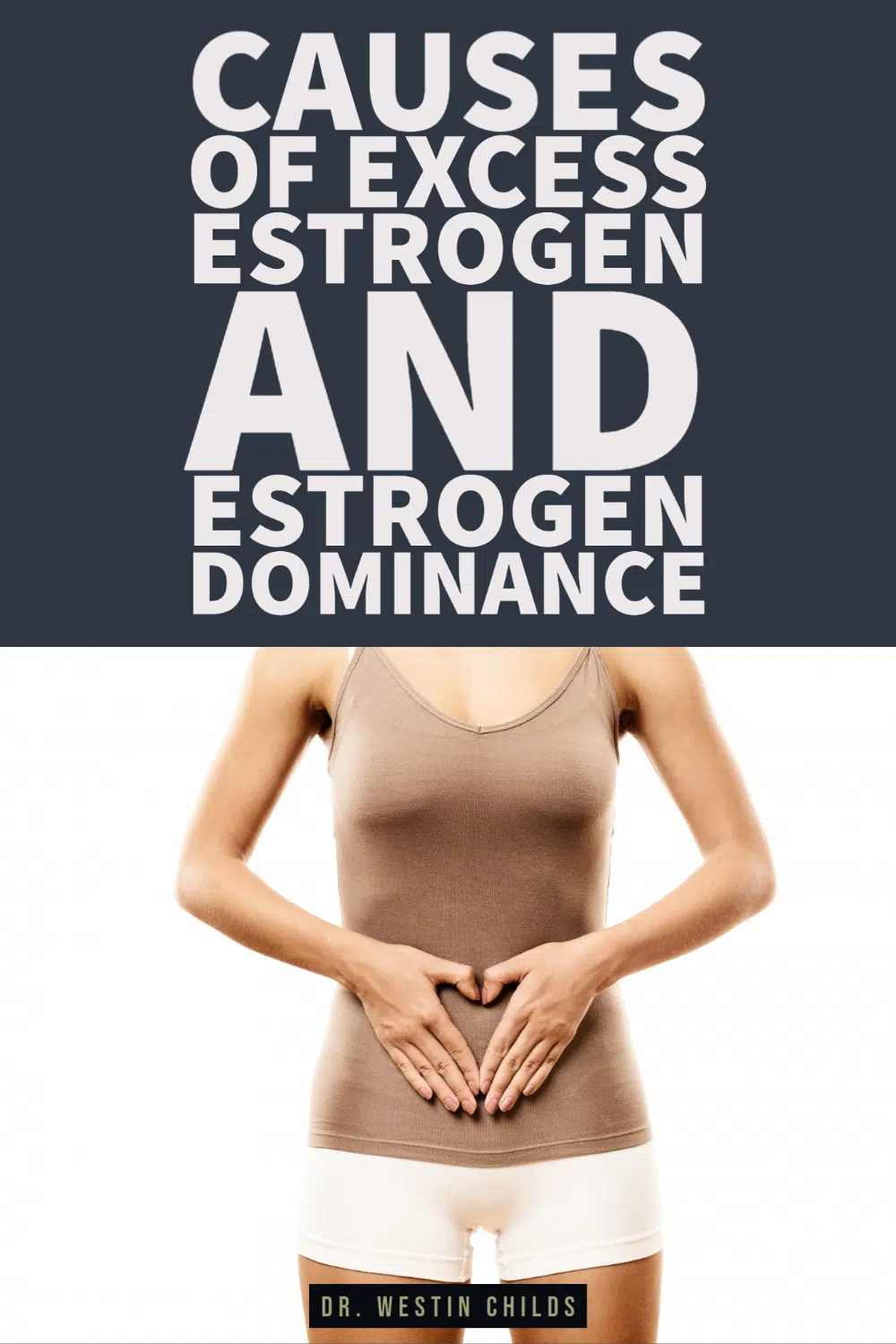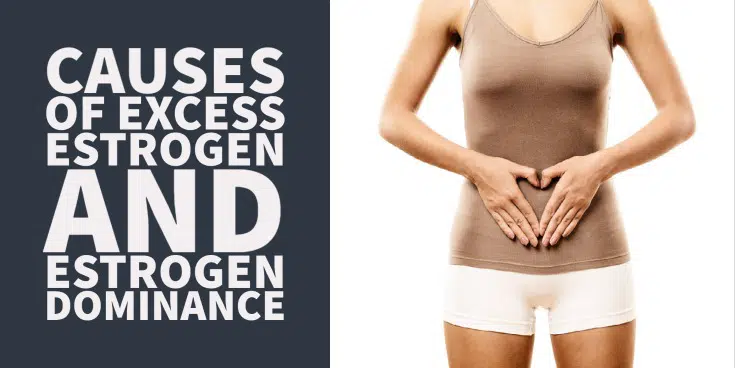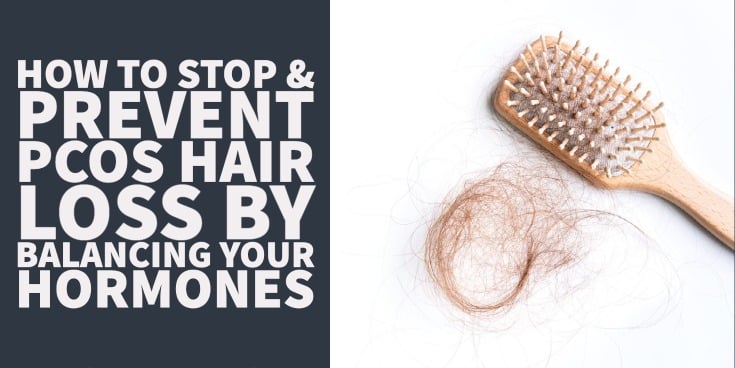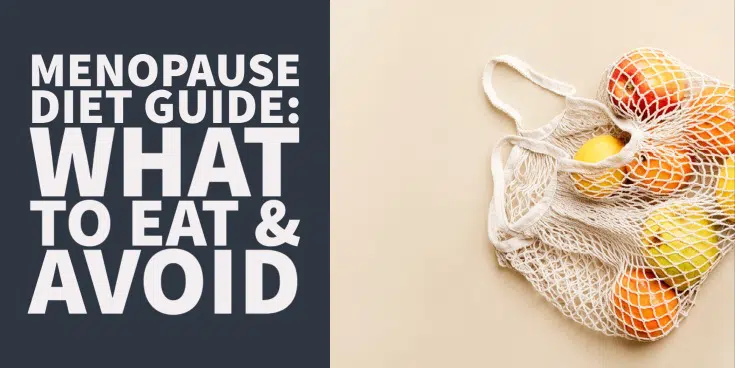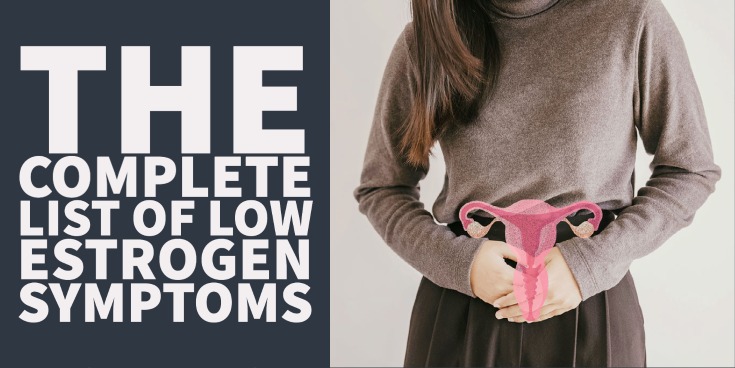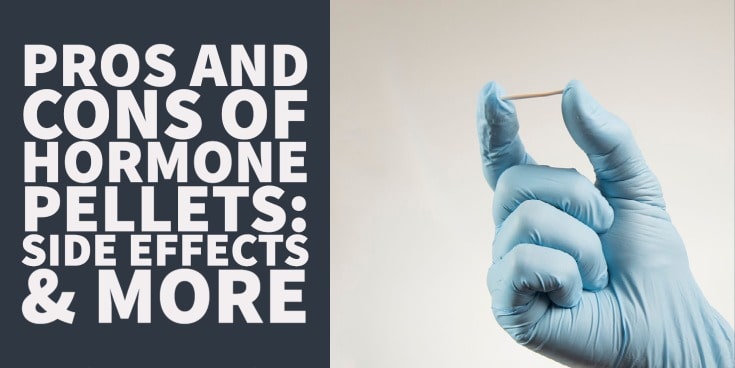You don’t have to be menopausal to experience the symptoms of estrogen dominance and you don’t necessarily even have to have high serum estrogen levels either.
Many women, though, may begin to experience issues relating to hormone imbalance as early as their late teens or early twenties.
If these imbalances are not addressed they can continue to gain momentum and lead to serious medical conditions such as endometriosis, PCOS, fibrocystic breast disease, infertility, and more.
Learn how to spot the symptoms of this condition and more importantly what to do about it…
What is Estrogen Dominance?
The simple answer is too much estrogen.
The long answer is a little more elaborate:
Estrogen dominance is a term that is used to describe a scenario in the body in which the influence of estrogen on cellular function is higher than what is considered “normal”.
This excessive cellular activation of estrogen receptors results in characteristic symptoms that can be identified and treated.
Estrogen dominance is basically used to describe a condition in the body in which estrogen levels are basically higher than normal.
In addition, because of the influence of progesterone on the body, estrogen dominance can also be caused by low progesterone (even in the face of normal estradiol levels).
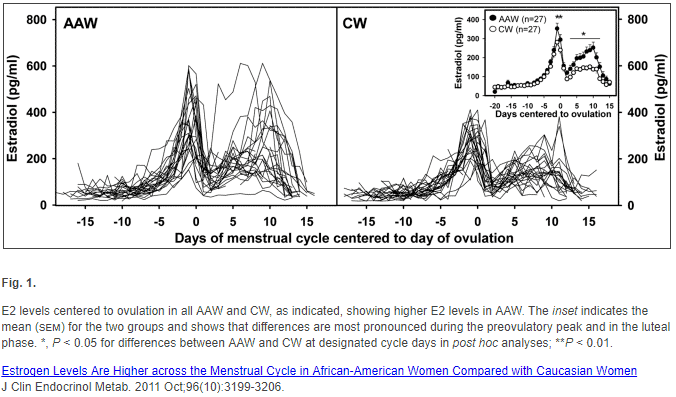
Normally estrogen and progesterone play a “balancing game” (1) in the body in which estrogen tends to activate certain functions in the body while progesterone tends to turn them off.
For instance:
Estrogen may increase fat cell size (2) while progesterone reduces or normalizes the impact that estrogen has on fat cells – thus balancing one another.
With this in mind, you can identify conditions or disease states which may result in estrogen dominance symptoms.
Broadly speaking there are 3 primary mechanisms that may cause estrogen dominance:
- #1. Excessive estrogen receptor activation (Various substances that look like estrogen can activate the estrogen receptor – the primary example being xeno-estrogens (3) or endocrine disruptors (4)).
- #2. Excessive estrogen production (High serum estradiol or estrogen metabolites).
- #3. Insufficient progesterone levels in the body (Low serum progesterone).
Women who suffer from the symptoms of estrogen dominance tend to have 1 or more of the following mechanisms contributing to sex hormone dysfunction in their bodies.
The good news is that the presence of these conditions often results in very specific symptoms that can help identify the problem…
Estrogen Dominance Symptoms List:
Fortunately, like some other hormone imbalances in the body, you can often identify the presence of estrogen dominance clinically by assessing clinical symptoms (this means by simply looking at how you are feeling or what you are experiencing day to day).
You should always confirm the official diagnosis with blood tests, but in many cases, symptoms alone can be very telling.
Estrogen dominance symptoms tend to follow closely with the symptoms associated with high estrogen and low progesterone.
The reason for this is the nature of estrogen and how progesterone and estrogen react with one another.
More important than their actual value is their relationship with one another.
For instance, you can get estrogen dominance symptoms in the following situations:
#1. High serum estrogen with normal serum progesterone (common in individuals who are overweight).
#2. Normal serum estrogen with low serum progesterone (very common among women who are only 10-15 pounds overweight and in women who have thyroid dysfunction).
#.3 Normal serum estrogen levels and normal serum progesterone levels but with excessive exposure to endocrine-disrupting chemicals.
#4. Progesterone resistance syndromes (such as PCOS and endometriosis)
If you notice you have the symptoms listed below then make sure to look for the above sex hormone patterns described above.
The complete list of estrogen dominance symptoms:
- Breast tenderness or breast fullness
- Decreased libido or reduced sex drive
- Weight gain (especially in the hips/thigh/butt region)
- Changes to your menstrual cycle (menstrual irregularity, heavy menstrual flow, or cramps/mood changes/migraines with your cycle)
- Hair loss such as brittle hair, hair thinning, or change in the color of your hair
- Problems with fertility (usually difficulty with conception compared to a high risk of miscarriage with low progesterone)
- Changes to your mood including depression, anxiety or not feeling like yourself
- Bloating in the stomach
- Water retention especially in the hands/feet and face
- Changes to your bowel movements
- Reduced energy or fatigue
- Changes to your sleeping patterns including insomnia or a reduction in the quality of your sleep
- Reduced or damaged metabolism – gaining weight even though you haven’t changed your diet
- Other hormone imbalances such as low testosterone and thyroid disease
It’s important to realize that each person will present with slightly different symptoms and you don’t have to have ALL of the symptoms listed above.
In addition, some women may experience certain symptoms with more severity than others.
For instance:
Some women tend to be sensitive to the weight-gaining effects of estrogen and may experience a 50+ weight gain with excess estrogen.
Other women, on the other hand, may experience significant mood disturbances but not have issues with their weight.
Causes of Estrogen Dominance & High Estrogen Levels
Luckily there are several known conditions and states that lead to estrogen dominance.
If you can identify these causes early (and treat them) then you can, in some cases, dramatically reduce your symptoms.
The problem with this approach is that many of the current or standardized treatments that exist for these conditions tend to be “behind the times”.
Meaning that your doctor may not have the knowledge necessary to help you with these problems or even recognize that they exist.
For this reason, it is important that you have an understanding of the causes and the various treatments available.
In some cases, simple lifestyle changes (such as changes to your diet (5)), food intake, and supplement regimen) can eliminate these symptoms.
In other cases, you may need medications or other therapies to help get control.
With that in mind, I’ve included a list of the most common causes of estrogen dominance below.
Weight Gain (As little as 10-15 pounds)
Probably the most common reason for excessive estrogen influence in the female body is due to excessive adipose tissue (or fat cells).
Fat cells can actually drive up estrogen levels by converting androgens into estrogens.
This process is known as aromatization (6) and is one of the main ways that women can maintain estrogen levels after menopause.
This mechanism becomes a problem as the body gains too much fat (sometimes as little as 10-15 pounds).
When this happens excess androgens that may be floating around in the body can be turned into estrogen (especially in breast fat tissue and belly fat tissue (7)).
The problem comes back full circle when you realize that extra fat can also increase circulating androgens (8) in the body (consider the case of PCOS).
So in a vicious cycle weight gain can result in high androgens which cause high estrogen and high estrogen may lead to further weight gain and the cycle repeats.
The good news is that stopping this cycle can be accomplished with weight loss.
The bad news is that sometimes this very condition can make weight loss very difficult.
Some women may have a very difficult time losing weight with estrogen dominance because high estrogen may influence other hormones such as leptin and thyroid hormone which lead to further weight gain and weight loss resistance.
You’ll know if you are in this boat if simple changes such as diet and exercise don’t really have an impact on your weight.
Exposure to Xeno-estrogens & Endocrine Disrupting Chemicals
Another common, but often overlooked, cause of estrogen dominance is exposure to xeno-estrogens (9) or endocrine-disrupting chemicals.
These are chemicals that are found in food products, plastics, and other common household items (10) and they can be detrimental to the body because of how your body processes them once they are absorbed.
Some of these chemicals have parts that look similar to the natural estrogen hormone that is circulating in your body.
If they look “similar” to the estrogen hormone then they can sit on estrogen receptors and “turn on” genetic transcription.
This makes your body think that it’s really estrogen doing the work when in reality it’s these chemicals that are doing it.
These chemicals have been termed “endocrine disrupting chemicals” or EDCs because they disrupt the normal mechanics and actions of hormones in your body.
These chemicals don’t just exist for estrogen either, studies have shown that certain chemicals can cause damage to your thyroid in a similar mechanism (11).
Another huge problem is that these chemicals are found ALL over the place.
From the foods that you consume to the makeup that you wear to the storage of these chemicals in your fat cells – they are all over the place.
You can see an example of how often you might come into contact with these EDCs on a daily basis:
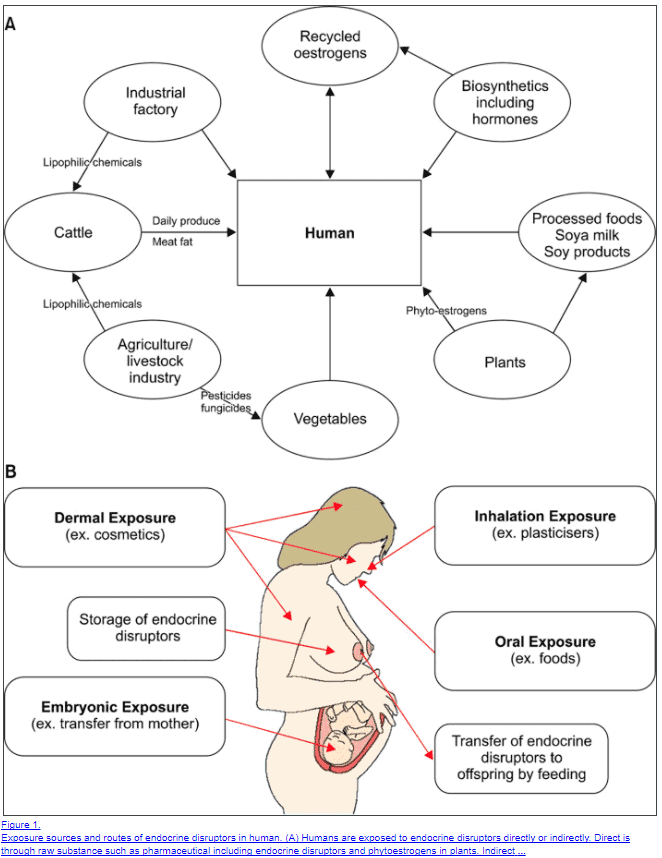
Not everyone will even have trouble with EDCs.
Due to genetics some people may come into contact with these chemicals and get rid of them without any issue.
But certain people, such as those with methylation issues or liver damage from conditions such as fatty liver disease, may not be able to get rid of them as easily and it is these patients that may suffer more than others.
Addressing exposure to EDCs may be as simple as reducing the number of chemicals you come into contact with on a daily basis.
You can do this with simple tactics such as drinking from glass bottles, avoiding microwaving plastic containers, consuming organic and all-natural foods, and avoiding cosmetics that contain these chemicals.
Some individuals, however, may also benefit from the use of certain supplements.
Low Serum Progesterone
Because progesterone is the natural balance to estrogen it’s important that you have a relative balance between both estrogen and progesterone in your body.
While most women vary in the absolute amount of estrogen and progesterone that they produce (and feel good with), this balance should still be somewhere around 10:1 using basic serum labs.
Even with normal estradiol, it’s possible to have low progesterone and therefore experience the symptoms associated with estrogen dominance.
How common is low progesterone (you can learn more about the symptoms of low progesterone here)?
It turns out, physiologically speaking, progesterone starts to decline (12) (at a rate more quickly than estrogen) starting around age 35 and leading up until menopause.
This means that MANY (most) aging women are likely to experience low progesterone from age alone.
Other conditions can also prematurely lower progesterone as well which can exacerbate the issue further.
The good news is that you can take a natural, bio-identical progesterone cream (in some cases) which can drastically alleviate the symptoms of excess estrogen in your body.
Natural bio-identical formulations of progesterone should be differentiated from synthetic hormones such as birth control pills – they do NOT work the same way.
Birth control pills may make estrogen dominance worse while progesterone can potentially alleviate the problem altogether.
The catch is that not all cases of estrogen dominance are caused by low progesterone in the first place so this treatment may not work for everyone.
You can read more about the use of progesterone cream here and how to use it both safely and effectively.
Progesterone Resistance Syndromes
Progesterone resistance syndromes (13) refer to a set of conditions that cause cellular resistance to the hormone progesterone.
It may sound confusing at first but it can easily be explained:
Certain conditions may lead to a downregulated (in total number) of progesterone receptors on certain cells.
This means that it requires higher and higher levels of progesterone to have the same effect.
Resistance syndromes also exist for other hormones such as insulin resistance and leptin resistance and they occur through similar mechanisms.
It’s not well understood exactly how progesterone resistance develops but it is suspected that high levels of estrogen probably contribute.
The idea stems from the fact that estrogen and progesterone can “cross-talk” with one another which means that high estrogen may influence progesterone receptors and vice versa.
Progesterone resistance syndromes can be difficult to treat but they have been shown to respond to bio-identical progesterone cream.
Thyroid Dysfunction (Hypothyroidism, “Sluggish” thyroid & under-active thyroid)
Thyroid dysfunction or more specifically hypothyroidism may alter sex hormone levels in the body.
You probably know about the importance of thyroid hormone in regulating your weight, mood, hair/skin/nails, GI tract, etc. but you may not realize it may also help maintain your progesterone/estrogen ratio.
One common side effect of untreated (or undertreated) hypothyroidism is infertility which may stem from low progesterone.
Thyroid hormone has been shown to stimulate progesterone release from luteal cells (14).
Low thyroid hormone (also known as hypothyroidism) may, therefore, lead to low progesterone, infertility, and an imbalance in sex hormone levels.
In addition, other studies (15) have shown that women with hypothyroidism have more menstrual disorders and suffer from sub-fertility when compared to women with normal thyroid function.
If you have the symptoms of estrogen dominance then it is very important to have a complete thyroid panel.
In fact, this should be part of the standard workup.
Why?
Because treating hypothyroidism may completely remove or reverse your symptoms.
How can you Reduce Estrogen Levels?
Is there a way to reduce estrogen levels, increase progesterone levels, and treat estrogen dominance?
The short answer is yes.
The long answer you can find below:
- Diet: The first step is to clean up your diet. You should focus on eating organic foods with loads of vegetables from the Brassica family. These vegetables contain ingredients like indole 3 carbinol that naturally help your body break down estrogen and increase estrogen metabolism. Estradiol is metabolized into multiple estrogen metabolites and some metabolites are more beneficial than others. Brassica vegetables increase healthy and helpful metabolites while reducing the negative ones.
- Certain Supplements: Certain supplements can augment estrogen metabolism and/or directly reduce the symptoms of estrogen metabolism. Supplements such as DIM, maca root, zinc, calcium-d-glucarate, and ashwagandha have been shown to help. I’ve put together a list of supplements that help reduce estrogen and you can read exactly how and why they work in this guide.
- Exercise & Strength Training: Exercise, particularly strength training has a positive impact on hormone balance in the body. In addition, women tend to do better by changing their exercise routines during their cycles. When testosterone levels are high (days 1-14 of your cycle) focus on more powerlifting exercises, while testosterone levels are lower (days 20-28 of your cycle) during your cycle focus on less intense exercises such as yoga/pilates.
- Stress Reduction: Addressing stress is important in balancing both estrogen and progesterone. Acute stress can cause a dramatic spike in sex hormone levels and cortisol while sustained levels may lead to resistance syndromes. You can learn how to address adrenal function through lifestyle changes and with certain supplements here.
- Bio-Identical Progesterone Cream: The use of natural progesterone cream can be life-altering for some people. Just because it works for some people doesn’t mean it should be used by everyone, however. Remember: even though progesterone cream is available over the counter it is still a powerful sex hormone and it is possible to use too much. You can learn more about using progesterone cream here.
- Detoxification: Estrogen is metabolized in the liver and you can make sure that you properly metabolize estrogen by ensuring proper liver function. Conditions such as fatty liver disease from being overweight may cause liver damage and result in impaired detoxification pathways. Make sure you optimize liver function if you are dealing with estrogen dominance with these tips.
- Check Other Hormones: We already know that thyroid hormone is important in sex hormone balance but other hormones may also contribute to various medical conditions. If you suffer from estrogen dominance make sure to test for these hormones: Testosterone, insulin, thyroid function, and leptin.
- Avoid synthetic hormones: If you are taking birth control medications or synthetic hormones you may find significant improvement by discontinuing these medications (providing it’s safe to do so). Synthetic medications are NOT bio-identical and may cause problems with normal hormone metabolism and even shut down or slow down normal hormone production. Discuss this with your physician before you stop any medication.
Over to you
Bottom line?
Estrogen dominance is a condition that results in characteristic symptoms from excessive estrogen production or excessive estrogen receptor influence.
These symptoms range from weight gain to mood changes to serious medical conditions.
The treatment for estrogen dominance depends on what is causing the problem in your body and therefore treatment should be individualized.
If you are suffering from the symptoms listed above then don’t hesitate to have your serum estrogen and progesterone levels assessed!
Now I want to hear from you:
Do you suffer from the symptoms discussed in this article?
Have you been able to treat or reduce your symptoms?
Why or why not?
Leave your comments below!
Scientific References
#1. https://www.ncbi.nlm.nih.gov/pubmed/11171605
#2. https://www.ncbi.nlm.nih.gov/pmc/articles/PMC3773840/
#3. https://www.ncbi.nlm.nih.gov/pmc/articles/PMC3388472/
#4. https://www.ncbi.nlm.nih.gov/pubmed/19478717
#5. https://www.ncbi.nlm.nih.gov/pubmed/16115348
#6. https://www.ncbi.nlm.nih.gov/pubmed/234975
#7. https://www.ncbi.nlm.nih.gov/pubmed/234975
#8. https://www.ncbi.nlm.nih.gov/pubmed/15531721
#9. https://www.ncbi.nlm.nih.gov/pubmed/18942551
#10. https://www.ncbi.nlm.nih.gov/pmc/articles/PMC2726844/
#11. https://www.ncbi.nlm.nih.gov/pubmed/21939731
#12. https://www.ncbi.nlm.nih.gov/pubmed/1424166
#13. https://www.ncbi.nlm.nih.gov/pubmed/16406281
#14. https://www.ncbi.nlm.nih.gov/pubmed/9846161
#15. https://www.ncbi.nlm.nih.gov/pubmed/26620017
